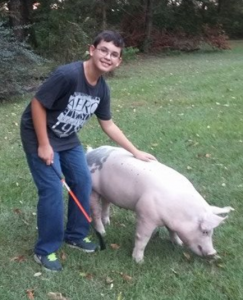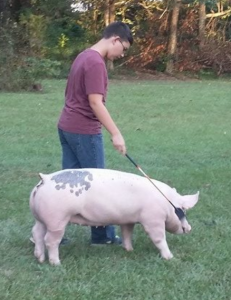
In the Florida Panhandle, it’s Fair Season! Whether you are an exhibitor or a spectator, we are sharing some tips for you related to the Swine Project. For spectators, it is important to understand the risks associated with disease and animals. Though rare, influenza can spread from pigs to people. The Centers for Disease Control (CDC) recommends that anyone who is at high risk of serious flu complications should avoid pigs and pig barns. For everyone else, just use good sense- don’t take food or drinks into the barn area. If you have young children, avoid taking toys or pacifiers into the barn area and make sure everyone washes their hands afterwards; most fairs provide handwashing stations just outside the barns. The CDC has some great tips for parents planning on attending livestock exhibits on their website.
For exhibitors, one component of your project will be learning to show your animal. Showmanship is judged on your ability to exhibit an animal to its best advantage. These skills take a lot of time and practice to gain, but having a well-trained animal will make it easier. Participating in a swine showmanship workshop is a great way to prepare. Contact your local UF IFAS Extension Office to find out when the next clinic will be held in your area.
Top 10 Tips for Preparing for a Swine Show:
- Make sure you have the proper tools and supplies and gather them in one place. A show box that can be locked is best, but anything you can use to keep everything together will work. Your show box should include items such as:
- Brush
- Mild soap
- Water hose
- Work clothes and boots for use when washing your pig
- Crop or cane
- Wash cloths and towels
- Rubber feed trough
- Shovel
- Water bucket
- Feed
- Bedding (if not provided by the show)
- Oil or powder if coat dressing is allowed (some shows will not allow coat dressing)
- Practice driving your pig as often as possible. Driving means guiding your animal from one place to another with a cane or crop. When using a cane, you will be using the curved end to touch the animal. To move you pig you lightly tap it either on the rear or on the shoulder.

Proper placement of your crop or cane is very important. NEVER beat your pig with it! - Brush your pig daily for at least two months before the show. Brush the hair in the direction it lays naturally. Pigs “love” to be rubbed and brushed and they will look forward to it.
- Make sure to wash your pig one or two times before the show. You will need to wash them the day before the show or at the show. Use a stiff brush and a mild detergent. Make sure to never get water in your pig’s ears as it will affect its equilibrium.
- When working your pig, pay attention to how he walks. If the hooves are too long, you may need to trim them. Do this two to three weeks before the show and ask an experienced person to help you. Trimming too close will cause them to be lame.
- When trimming hair, make sure to clip off all the long hair from under the ear a few days ahead of the show. For a winter show, if your pig has long hair, you can clip the underline to make the pig appear trim in the middle.
- Gather your show clothes. Clean pressed jeans or slacks and a neat button-down or sport shirt, not a T-shirt. 4-H attire is always nice! Tuck in your shirt, and wear a belt for added neatness. It is best not to wear a cap since it may take the judge’s concentration away from the animal. Wear leather shoes or boots for safety and appearance. If the animal steps on your foot, it is much easier for the foot to slip off a leather boot than a tennis shoe and leather shoes are thicker.
- Make sure you have all the proper registration and health forms. Place them in a folder or plastic sleeve to keep them clean and protected.
- Have a plan for transporting your pig. Transporting at night or early in the morning during hot weather is best.
- A good showman knows about their project animal. Sometimes the judge will ask questions to make a final decision on the top showman, so be prepared! Questions may include the weight, gender, breed, age, or parts of the animal. They may also include carcass composition, swine management practices, feeding and nutrition, or marketing systems.
The UF Animal Sciences Department is offering a Swine Field Day and Sale October 22nd. The field day will include instruction on showmanship, feeding and fitting youth hog. These fact sheets offer even more information to help you successfully raise and show your hog:
Once you have mastered how to show a pig, you may want to consider enrolling in the 4-H Hog and Ham Project, a statewide 4-H program which takes the participant through the total process of pork production from beginning to end. Youth select a feeder pig and grow it to harvesting weight, all the while keeping records of feed amounts and costs, health care, expenses and weights. After harvesting and processing the the hog, 4-H’ers cure the hams and prepare bacon and sausage for smoking. The project concludes by participating in a retail comparison project, completing a record book, and presenting a demonstration or illustrated talk to the other participants.
Do you have a passion for pigs? If so, consider serving as a volunteer to help the next generation gain life skills through the swine project. We need your knowledge and experience to mentor youth enrolled in the swine project. For more information, contact your local UF IFAS County Extension Office or visit http://florida4h.org.
 1
1

